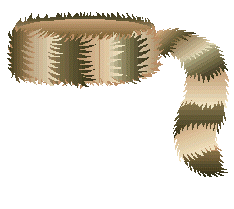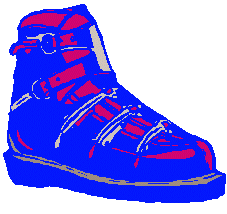

Like every sport skiing has been through plenty of fads over the years. One we recall were what we called "fast hats". These were hand knitted wool and resembled in pattern Sherpa hats to some degree. Coming out of the crown was a tail which flopped around as one skied. And there were strings that tied under the chin. Most of us took particular pride in making our own but mine was made by one of the girls in the Wasatch Club who took pity on my feeble efforts. I do recall knitting my own tassel or tail for the hat but even this had some misses in stitches I dropped.
These were popular in the late 1940s and early 1950s. My roommate in Salt Lake, Jack Schroeder, thought them particularly odious and even had a fictional cartoon sports handcapper named Emelin the Gremlin wearing one through a long basketball season. Fast Hats were warm and very comfortable but they did gather snow in a snowstorm or after a "header" in powder. Mine was eventually passed on to one of my sons when he started skiing at the age of three. Being made of wool it easily shrunk enough to fit him nicely. He wore it until he became old enough to object. One last note on fast caps. Much to my amusement and some degree of horror a long time acquaintance, a peer in age and skiing ability, actually wore one on the hill a few years back. I said nothing but thought they looked far better on a twenty five year old than on a man in his late sixties. After fast hats I had moved on to a Daniel Boone Coonskin Cap which superseded fast hats in popularity. This hat too was soon acquired by one of my sons.
Like most everything in the last half of the twentieth century technology made huge changes in skiing. Over the years we went through many changes in bindings. The goal was always to keep the heel to the ski, not easily accomplished with cable bindings. For a few seasons in Utah I used something called "super diagonals" which was a piece of thick rubber worn over the boot with a clip that attached to the back of the ski binding. The main objection was forgetting to slip it over the foot before putting on the boot. Remember they were leather boots and had to be laced, often with inner and outer sets of laces. Forgetting one super diagonal meant some rather coarse language since they would not fit over the boot which meant a second uncalled for bootup.
Very popular for a few years in the early 1950s were "long thongs". These were invented by French racers and were nothing more than a long thin piece of leather that was wound over the instep of the boot in elaborate fashion. Once on it took a major event for the skier to remove his skis. No quick release with long thongs. For once I resisted a trend and never used them myself. A cartoon of the era described them best. It showed a pair of skis sticking out the bottom of the door of an outhouse. A passing skier comments, "Wears long thongs, no doubt."
Ski Frees were the first safety binding that I used. They first showed in the marketplace in 1949. They were a wonderful improvement from the old "bear trap" binding used to that point in time. In a fall the front part of the foot could pivot and be released from the ski, something certainly not possible with "bear traps" which were well named. These first ski frees were still used with cable binding and could not be used for cross country.
The first heel plate binding I ever saw was in Sanpete County. It was designed and made by a local machinist who was a mechanical genius. At long last the heel was kept firmly to the ski. I never learned if this man made any money from his wonderful creation. But it was the granddaddy for every binding made to this day.
Head and Hart were the first medal skis that were taken seriously. The Heads, even early models, were vastly superior in powder or soft snow. But on hard pack or ice they were impossible. I was slow to change to metal skis. For one thing they were very expensive to my way of thinking. Also their performance in hard pack or racing left much to be desired.
Plastic bottoms were showing up on wooden skis by 1950. Also kits were sold so that existing skis could have plastic bottoms. These first "do it yourself" kits were tricky to the extreme. Two different compounds had to mixed together and air temperature had to be just right. Too cold and the plastic would not set--too warm and it set rapidly making for frantic efforts by the installer. I regret to state at one time or another I experienced all of the above.
As I said earlier I was relatively late moving to metal skis. I had bought a pair of Italian wooden skis, naturally marked way down in price. The first time I used them I broke one tip, at the top of the mountain, of course. Fortunately they came with a breakage warranty. I returned them and was given a new pair. A few weeks later I broke this second pair as well. This time the owner of the ski shop was tired of seeing me and offered me a deal I couldn't refuse on a pair of Harts.
I liked the Harts except for one thing. They were the slowest running ski I every owned. Somehow the plastic bottom did not create a good running surface. They required all my hard won knowledge of waxing to be even reasonably fast.
And like the Heads on hard snow or ice they were all chatter. So much so that I still kept some stiff wooden skis for such conditions. One pair I bought for $10. They were made in Japan and were the stiffest skis imaginable. They had no flex in them at all. But they were wonderful on ice. Like the Italian skis they now also grace the house as picture frames.

Boots too were changing. Laces gave way to buckles although the boots were still made of leather. I recall the first buckle boots I purchased. It was off season and a sporting goods store was having an inventory sale. I talked Jim Wegner into going with me to try on boots. He was taking care of his two year old daughter, Pam that day, so we brought her along. This proved if nothing else that our early carefree days had changed as well. I was holding her while he was trying on boots and got a good soaking as she wet her pants. This incident caused much merriment for years after. Now 35 years later Pam and I pass jokes to each other via e mail.
There could be no joy in skiing with ill fitting boots. I recall skiing at Squaw Valley in a new pair of leather buckle boots and they were hurting so bad I thought I was through for the day. But I took them to the ski shop and fortunately found the right person to solve the problem. He just grinned and told me to take off the boots. He pointed them both against the wall and then hit each boot as hard as he could with a baseball bat behind the heel. And the problem was solved. I never had a bit of discomfort from that pair of boots again.
The next step forward was when Lange introduced the all man- made material plastic boot. This stiff high formed boot made all the difference in skiing techniques. I pointed this out in an earlier chapter when I was forced to go back to leather boots for a time because of an ankle injury. Maybe the best thing of modern boots is they require no maintenance. Leather boots were a constant bother. They needed to be dried, waxed, polished or treated with snow seal. On a Spring trip in wet snow they never really dried completely.
No one mourned their passing.


Graphic Design by Impact Graphics